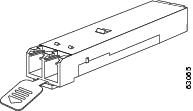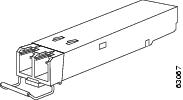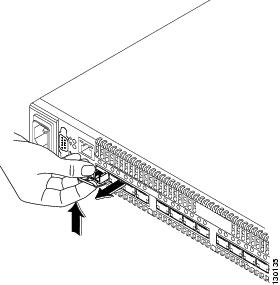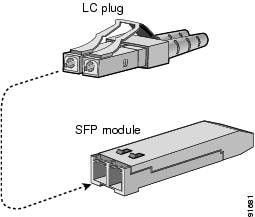

Table Of Contents
Connecting the Cisco MDS 9020 Switch
Preparing for Network Connections
Connecting the 10/100 Ethernet Management Port
Connecting to a Fibre Channel Port
Removing and Installing SFP Transceivers
Removing and Installing Cables into SFP Transceivers
Installing a Cable into an SFP Transceiver
Removing a Cable from an SFP Transceiver
Maintaining SFP Transceivers and Fiber Optic Cables
Connecting the Cisco MDS 9020 Switch
The Cisco MDS 9020 Fabric Switch provides the following types of ports:
•
Console port (Interface Module)—An RS-232 port that you can use to create a local management connection.
•
MGMT 10/100 Ethernet port—An Ethernet port that you can use to access and manage the switch by IP address, such as through the CLI or Fabric Manager.
•
Fibre Channel ports — Fibre Channel ports that you can use to connect to the SAN.
This chapter describes how to connect the various components of the Cisco MDS 9020 Fabric Switch, and it includes the following information:
•
Preparing for Network Connections
•
Connecting the 10/100 Ethernet Management Port
•
Connecting to a Fibre Channel Port
Preparing for Network Connections
When preparing your site for network connections to the Cisco MDS 9020 Fabric Switch, consider the following for each type of interface:
•
Cabling required for each interface type
•
Distance limitations for each signal type
•
Additional interface equipment needed
Before installing the component, have all additional external equipment and cables available.
Connecting the Console Port
This section describes how to connect the RS-232 console port to a PC. The console port allows you to perform the following functions:
•
Configure the switch from the CLI.
•
Monitor network statistics and errors.
•
Configure SNMP agent parameters.
•
Download software updates to the switch or distribute software images residing in Flash memory to attached devices.
The console port, located on the front panel, is shown in Figure 3-1.
Figure 3-1 Console Port
For local administrative access to the Cisco MDS 9020 Fabric Switch, you can connect the PC serial port to the switch console port with the console cable included with the switch. The console cable, or roll over cable, is a null-modem DB9 cable.
Note
The PC must support VT100 terminal emulation. The terminal emulation software—frequently a PC application such as HyperTerminal Plus—makes communication between the Cisco MDS 9020 Fabric Switch and your PC possible during setup and configuration.
To connect the console port to a PC, follow these steps:
Step 1
Configure the baud rate and character format of the PC terminal emulation program to match the following management port default characteristics:
•
9600 baud
•
8 data bits
•
1 stop bit
•
No parity
•
Flow control: none
Step 2
Connect a null-modem DB9 cable from the switch console port to the PC serial port.
Connecting the 10/100 Ethernet Management Port
The autosensing 10/100 Ethernet management port is located on the left side of the front panel, to the right of the console port. This port is used for out-of-band management of the Cisco MDS 9020 Fabric Switches. Use modular, RJ-45, straight-through UTP cables to connect the 10/100 Ethernet management port to external hubs, switches, and routers. The default IP address is 10.0.0.1.
Connecting to a Fibre Channel Port
The Fibre Channel ports are compatible with LC-type fiber-optic SFP transceivers and cables. The Cisco MDS 9020 Fabric Switch supports the Fibre Channel protocol for SFP transceivers. Each transceiver must match the transceiver on the other end of the cable, and the cable must not exceed the stipulated cable length for reliable communications. Refer to the Release Notes for Cisco MDS 9020 Fabric Switch for FabricWare Release 2.1(2) for the list of specific supported SFP transceivers. SFP transceivers can be ordered separately or with the Cisco MDS 9020 Fabric Switch.
Warning
Class 1 laser product. Statement 1008
Warning
Invisible laser radiation may be emitted from disconnected fibers or connectors. Do not stare into beams or view directly with optical instruments. Statement 1051
CautionWear an ESD wrist strap connected to the chassis when handling transceivers. Keep optical connectors covered when not in use, and do not touch connector ends. The fiber-optic connectors must be free of dust, oil, and other contaminants.
This section provides the following information:
•
Removing and Installing SFP Transceivers
•
Removing and Installing Cables into SFP Transceivers
•
Maintaining SFP Transceivers and Fiber Optic Cables
Removing and Installing SFP Transceivers
CautionRemoving and installing an SFP transceiver can shorten its useful life. Do not remove and insert SFP transceivers more often than is absolutely necessary. We recommend disconnecting cables before installing or removing SFP transceivers to prevent damage to the cable or transceiver.
Note
Use only Cisco optical SFP transceivers on the Cisco MDS 9020 Fabric. Each Cisco SFP transceiver is encoded with model information that enables the switch to verify that the SFP transceiver meets the requirements for the switch.
The Cisco MDS 9020 Fabric Switch supports SFP transceivers with the following two types of latching devices:
· Mylar tab latch (Figure 3-2)
· Bale-clasp latch (Figure 3-3)
Figure 3-2 SFP Transceiver with Mylar Tab Latch
Figure 3-3 SFP Transceiver with Bale-Clasp Latch
Installing an SFP Transceiver
To install an SFP transceiver, follow these steps:
Step 1
Attach an ESD-preventive wrist strap and follow its instructions for use.
CautionIf the transceiver does not install easily, ensure it is correctly oriented and the tab or clasp are in the correct position before continuing.
Step 2
Remove the dust cover from the port cage.
Step 3
Remove the dust cover from port end of the transceiver.
Step 4
Insert the transceiver into the port:
•
If the transceiver has a Mylar tab latch, orient the transceiver with the tab on the bottom, then gently insert transceiver into the port until it clicks into place.
•
If the transceiver has a bale-clasp latch, orient the transceiver with the bale clasp on the bottom, close the bale clasp by pushing it up over the transceiver, then gently insert the transceiver into the port until it clicks into place.
Step 5
If a cable will not be installed in the transceiver, insert or leave the dust plug in the cable end of the transceiver.
Removing an SFP Transceiver
To remove an SFP transceiver, follow these steps:
Step 1
Attach an ESD-preventive wrist strap and follow its instructions for use.
Step 2
If cable is installed in the transceiver:
a.
Record the cable and port connections for later reference.
b.
Press the release latch on the cable, grasp the connector near the connection point, and gently pull the connector from the transceiver.
c.
Insert a dust plug into the connector on the cable.
d.
Insert a dust plug into the cable end of the transceiver.
Tip
If the transceiver does not remove easily in the next step, push the transceiver all the way back in then ensure the latch is in the correct position before continuing.
Step 3
Remove the transceiver from the port:
•
If the transceiver has a Mylar tab latch, gently pull the tab straight out (do not twist), then pull the transceiver out of the port.
•
If the transceiver has a bale-clasp latch, open the clasp by pressing it downwards, then pull the transceiver out of the port.
Note
If you have difficulty removing a bale clasp SFP transceiver, you should re-seat the SFP by returning the bale clasp in the up position, then press the SFP inward and upward into the cage. Next, lower the bale clasp and pull the SFP straight out with a slight upward lifting force. (Figure 3-4.) Be careful not to damage the port cage during this process.
Figure 3-4 Alternate Removal Method for Bale Clasp SFP Transceivers
Step 4
Insert a dust cover into the port end of the transceiver and place the transceiver on an antistatic mat or into a static shielding bag if you plan to return it to the factory.
Step 5
If another transceiver is not being installed, protect the optical cage by inserting a clean cover.
Removing and Installing Cables into SFP Transceivers
CautionTo prevent damage to the fiber optic cables, do not place more tension on them than the rated limit and do not bend to a radius of less than one inch if there is no tension in the cable, or two inches if there is tension in the cable.
Installing a Cable into an SFP Transceiver
CautionTo prevent possible damage to the cable or transceiver, install the transceiver in the port before installing the cable in the transceiver.
To install a cable into a transceiver, follow these steps:
Step 1
Attach an ESD-preventive wrist strap and follow its instructions for use.
Step 2
Remove the dust cover from the connector on the cable.
Step 3
Remove the dust cover from the cable end of the transceiver.
Step 4
Align the cable connector with the transceiver and insert the connector into the transceiver until it clicks into place (see Figure 3-5).
Figure 3-5 Connecting the LC-Type Cable to a Fibre Channel Port
CautionIf the cable does not install easily, ensure it is correctly oriented before continuing.
For instructions on verifying connectivity, refer to the Cisco MDS 9020 Fabric Switch Configuration Guide and Command Reference.
Removing a Cable from an SFP Transceiver
CautionWhen pulling a cable from a transceiver, grip the body of the connector. Do not pull on the jacket sleeve, because this can compromise the fiber-optic termination in the connector.
CautionIf the cable does not remove easily, ensure that any latch present on the cable has been released before continuing.
To remove the cable, follow these steps:
Step 1
Attach an ESD-preventive wrist strap and follow its instructions for use.
Step 2
Press the release latch on the cable, grasp the connector near the connection point, and gently pull the connector from the transceiver.
Step 3
Insert a dust plug into the cable end of the transceiver.
Step 4
Insert a dust plug onto the end of the cable.
Maintaining SFP Transceivers and Fiber Optic Cables
SFP transceivers and fiber optic cables must be kept clean and dust-free to maintain high signal accuracy and prevent damage to the connectors. Attenuation (loss of light) is increased by contamination, and should be kept below 0.35 dB.
Maintenance guidelines:
•
SFP transceivers are static sensitive. To prevent ESD damage, wear an ESD-preventive wrist strap that is connected to the chassis.
•
Do not remove and insert a transceiver more often than necessary. Repeated removals and insertions can shorten its useful life.
•
Keep all optical connections covered when not in use. If they become dusty, clean before using to prevent dust from scratching the fiber optic cable ends.
•
Do not touch ends of connectors. This prevents fingerprints and other contamination of the connectors.
•
Clean regularly; the required frequency of cleaning depends upon the environment. In addition, clean connectors if they are exposed to dust or accidentally touched. Both wet and dry cleaning techniques can be effective; refer to your site's fibre optic connection cleaning procedures.
•
Inspect routinely for dust and damage. If damage is suspected, clean and then inspect fiber ends under a microscope to determine if damage has occurred.

 Feedback
Feedback







